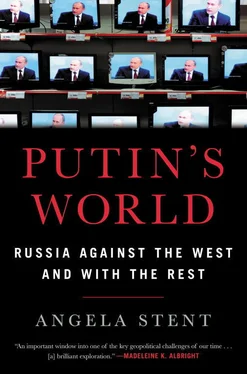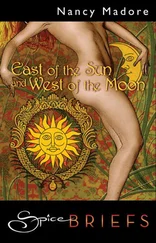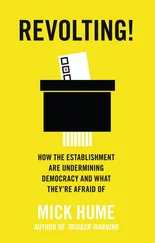In the immediate aftermath of the Soviet collapse, there was a broad effort to bring to light Stalin’s crimes and to confront that period of Soviet history. Memorial, a human rights NGO dedicated to exposing the truth about Stalin’s victims, and to promoting human rights in Russia, did impressive work, including finding many previously hidden graves of his victims. But after Putin became president, the official view of Stalin began to change yet again. Despite his crimes, he was an “efficient manager” and a “patriot.” 11In 2015, Memorial’s status as an NGO was challenged, and it has faced continuous harassment. Stalin has gradually been rehabilitated in school textbooks as a great leader who made the world respect and fear the USSR.
Vladimir Putin’s version of the past—designed to bolster Russian patriotism and support for him—has been quite effective. History informs any country’s leader and population of their role in the world. But in Russia the past haunts the present more vividly than in many other countries, perhaps because Russia has yet to develop a national narrative to which its population can fully subscribe. For centuries, a disparity between Russia’s self-concept as a great power and the reality of its capabilities—both natural and man-made—has limited its ability to play the world role it believes it is destined to play. These capabilities have determined Russia’s interactions with the outside world.
THE PERSISTENT FACTORS IN RUSSIAN FOREIGN POLICY
Size and Climate
Russia’s understanding of its role in the world begins with a basic geographical reality. Since the sixteenth century it has been the largest country in the world occupying a strategic swath of territory in the heartland of Eurasia, astride two continents and spanning eleven of the world’s twenty-four time zones. It has only one natural border, the Arctic sea to the north. Otherwise it has constantly had to redefine its borders. Russia’s size as a single consolidated state that has survived for centuries and resisted conquest makes it unique in world history. Invaders have come from the east, south, and west and have eventually been pushed back. And there are few aspects of Russian life on which the country’s enormous size has not had an impact. 12Russia’s size certainly helped it resist conquest by outside powers, but it also retarded its ability to modernize. The vast distances made communication difficult.
Added to Russia’s size is the enormous diversity in its extreme climate. Large parts of the country were virtually inaccessible in the winter, the growing season was short, and there were few warm-water ports. Although Russia and Canada are on the same latitude, most Canadians live along its southern border. But Russian leaders uniquely settled large numbers of their population in the inhospitable far north, where many of its natural resources were. The fact that roads and rivers were frozen for much of the year further impeded economic development. Moreover, Russia has always been a relatively sparsely populated country. It is rich in natural resources: oil, gas, precious metals, and timber. But most Russians live far away from where these abundant resources are, and it has always been a challenge to fully exploit them.
Soviet leaders moved large numbers of people to Siberia to work with Russia’s natural riches, but at a very high human and material cost. The town of Norilsk, founded in the 1930s, is an extreme example of this trend. It is above the Arctic Circle, the northernmost city in the world, has 175,000 permanent inhabitants, and was initially founded as part of Stalin’s GULAG, or labor camp, system. It is snowed under for 250 days a year, has temperatures ranging from minus 64 degrees Fahrenheit in the winter to 77 degrees in the summer. It produces valuable nickel and other commodities, but living conditions can be very difficult. 13
Economic Backwardness
Russia’s size, difficult climate, and relatively sparse population have for centuries challenged its leaders as they sought to develop the country economically. But Russia’s persistent relative economic backwardness compared to Europe was also the product of its leaders’ choices. The tsars feared the creation of a middle class that might challenge the absolute monarchy and delayed encouraging the development of a capitalist economy. Stalin imposed industrialization and forced agricultural collectivization of the Soviet population from above, to drag the USSR out of its backward state. He abolished whatever remained of private property. He herded unwilling peasants onto collective farms, forced others to move into the industrial cities, and presided over the deaths of many others. But ultimately the dysfunctional Soviet economic system proved unable to keep up with the West as the era of modern technology dawned.
The Imperative of Centralized Rule and Russification
But perhaps the most important impact of Russia’s size has been the way tsars and general secretaries have ruled their people. Whether the capital was in Saint Petersburg or Moscow, the issue has been how to govern such a vast, ethnically diverse country, which is 6,000 miles wide (the United States, for instance, is 2,600 miles wide). As the Russian state expanded from the sixteenth century on, it conquered wide-ranging groups of people. By the time Russia’s expansion was over, at the end of the nineteenth century, the empire was home to more than one hundred ethnic groups at very different stages of social and economic development. Some of them—notably the Poles and Chechens—resisted Russian rule and openly rebelled against it. Successive attempts to solidify St. Petersburg’s rule by imposing a policy of Russification on potentially rebellious non-Russian groups succeeded only partially. No wonder Lenin called the Russian Empire at the turn of the century a “prison house of nationalities.”
The Chechens have actively resisted Russian rule since the early nineteenth century. Leo Tolstoy’s late-nineteenth-century novella Hadji Murad, a story of Russia’s wars with Chechnya, is a testament to the ongoing struggle with the North Caucasus’s Islamic groups. Others—such as the various nomadic tribes in Central Asia—were more accommodating to the Russian Empire. But the tsars and later the Soviets realized that Russia would always face an internal security problem. The solution was to govern with an iron hand from the capital, dispatching bureaucrats far and wide to collect taxes and impose the laws. And the rulers were always wary of sedition and treason. Tough penalties for criticizing the tsar and centralized autocratic rule have characterized Russia for centuries. The 1649 law code provided for the death penalty if someone in word and deed ( slovo i delo ) criticized the tsar, meaning that a peasant drinking too much in a tavern had to be careful about what he said about his ruler lest someone overhear and report him.
THE IMPROBABLE “START-UP”
Russia was in many ways an improbable country. Its natural endowments—its size, extreme climate, often impassable roads, and huge distance from centers of world trade and civilization (both the ancient trade routes in Persia and China and the more modern Atlantic routes)—all contributed to retard its progress toward modernity. “Russia was remote in time and space… a ‘start-up’ founded hundreds of miles from the rest of civilization in a vast forest.” 14Its location helped it survive. Russia was not accessible by sea, and it managed to fend off several waves of European would-be invaders. And then there was the climate. The adage that General Winter defeated both Napoleon and Hitler when they sought to conquer Russia is the ultimate testimony to the country’s ability to persevere and resist until the enemy succumbed to the cold and ice. These enemies of Russia, as Putin is fond of reminding the world, underestimated the ability of Russians to endure and overcome adversity.
Читать дальше












